2024年中考英语第一轮课本复习课件三:七下Units 1-4
文档属性
| 名称 | 2024年中考英语第一轮课本复习课件三:七下Units 1-4 |  | |
| 格式 | pptx | ||
| 文件大小 | 1.4MB | ||
| 资源类型 | 试卷 | ||
| 版本资源 | 通用版 | ||
| 科目 | 英语 | ||
| 更新时间 | 2024-02-26 21:16:14 | ||
图片预览

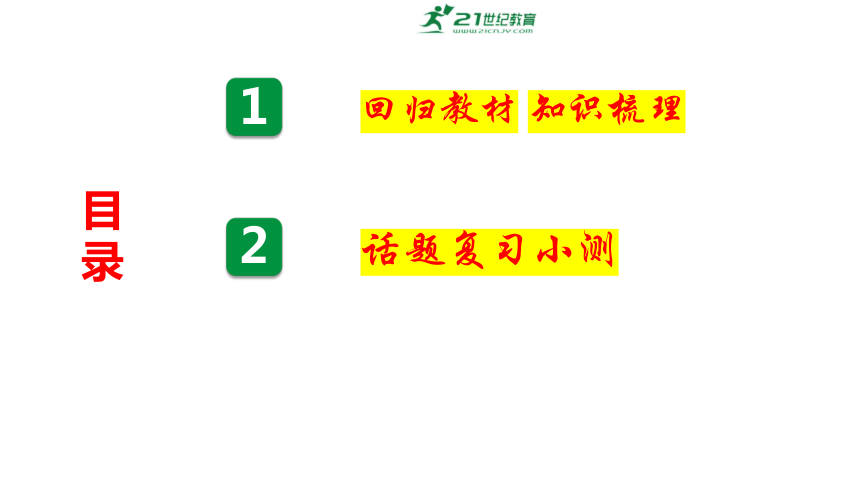
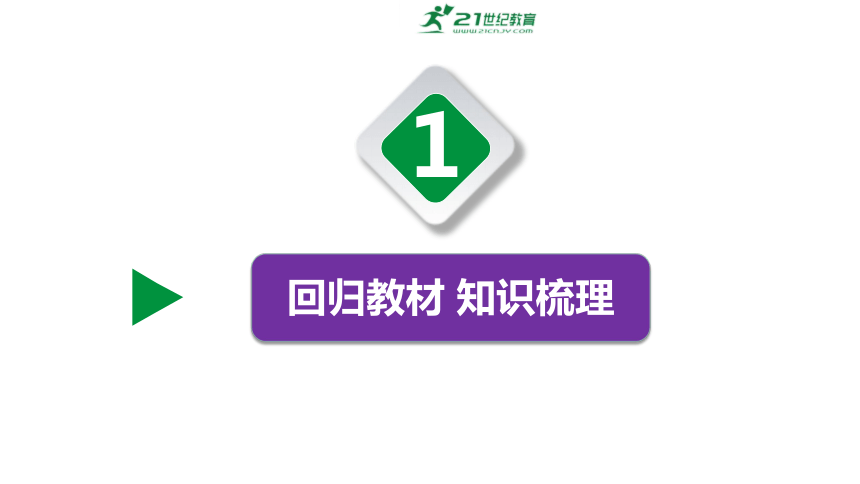
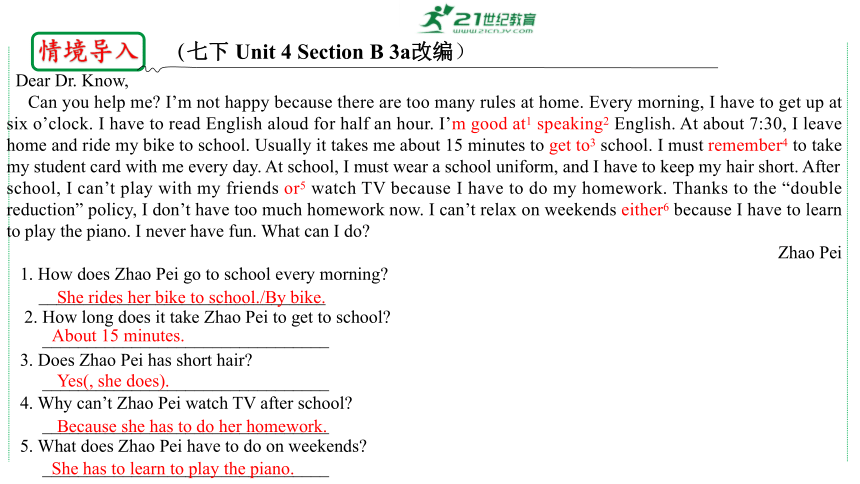
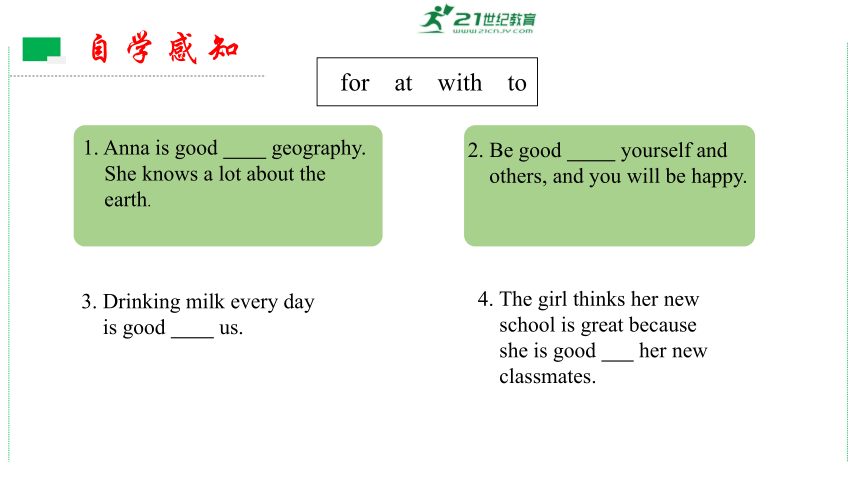
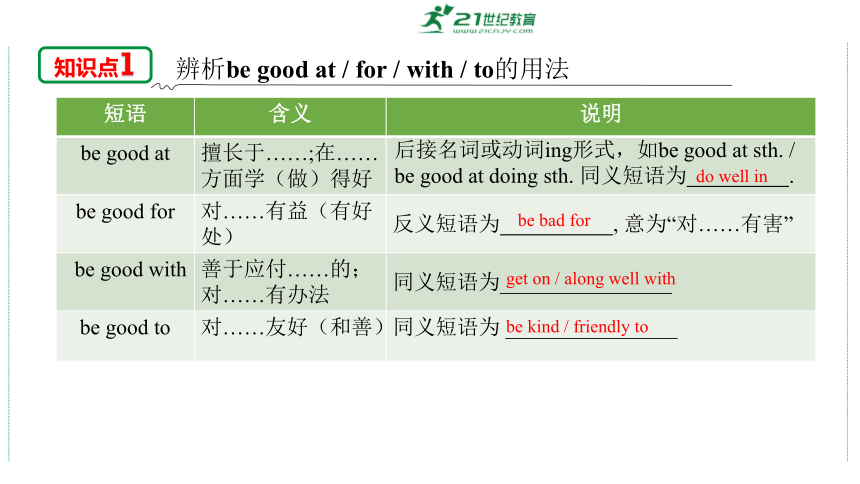
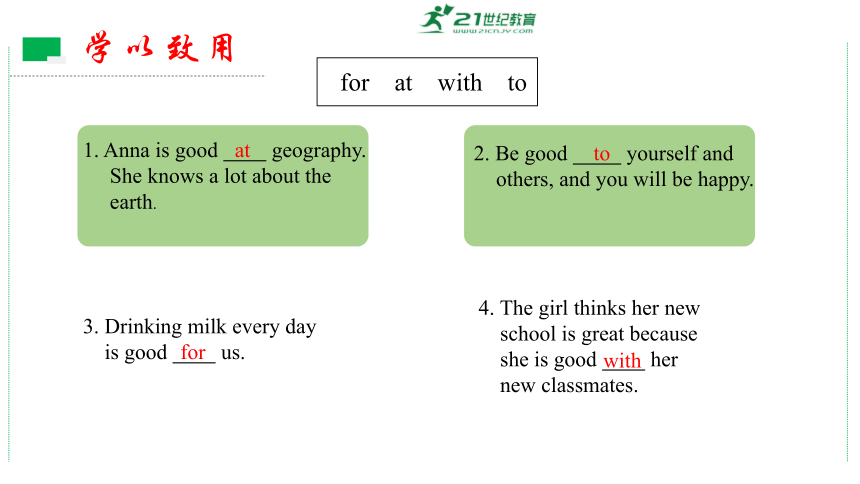

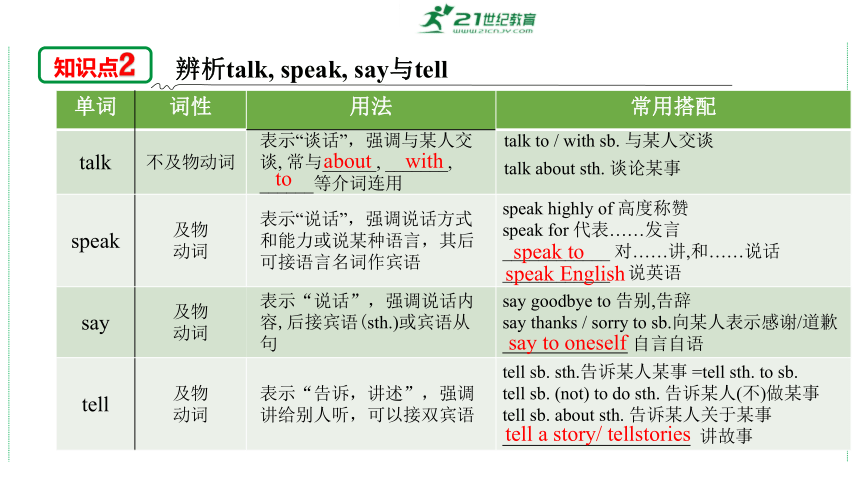


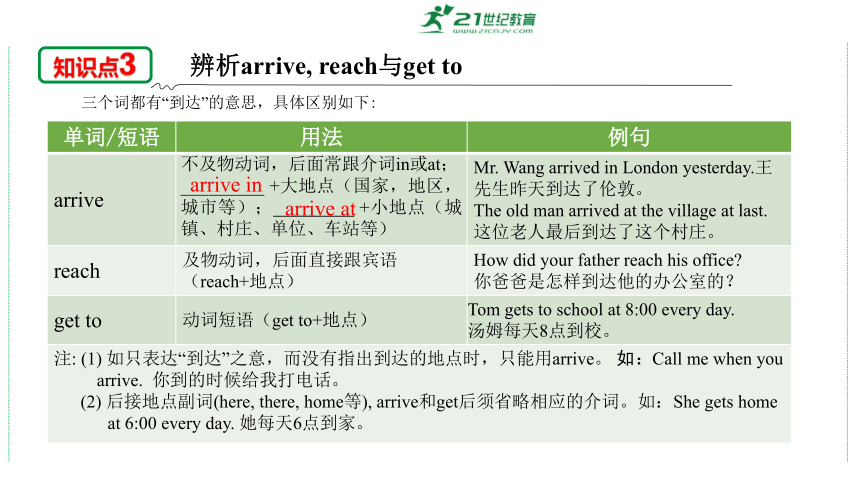
文档简介
(共41张PPT)
七年级下册 Units 1—4
2024年中考复习专题
回归教材 知识梳理
话题复习小测
话题复习小测
情境导入
Dear Dr. Know,
Can you help me I’m not happy because there are too many rules at home. Every morning, I have to get up at six o’clock. I have to read English aloud for half an hour. I’m good at1 speaking2 English. At about 7:30, I leave home and ride my bike to school. Usually it takes me about 15 minutes to get to3 school. I must remember4 to take my student card with me every day. At school, I must wear a school uniform, and I have to keep my hair short. After school, I can’t play with my friends or5 watch TV because I have to do my homework. Thanks to the “double reduction” policy, I don’t have too much homework now. I can’t relax on weekends either6 because I have to learn to play the piano. I never have fun. What can I do
Zhao Pei
1. How does Zhao Pei go to school every morning
________________________________
2. How long does it take Zhao Pei to get to school
________________________________
3. Does Zhao Pei has short hair
________________________________
4. Why can’t Zhao Pei watch TV after school
________________________________
5. What does Zhao Pei have to do on weekends
________________________________
(七下 Unit 4 Section B 3a改编)
She rides her bike to school./By bike.
About 15 minutes.
Yes(, she does).
Because she has to do her homework.
She has to learn to play the piano.
自学感知
for at with to
1. Anna is good geography.
She knows a lot about the
earth.
2. Be good yourself and
others, and you will be happy.
3. Drinking milk every day
is good us.
4. The girl thinks her new
school is great because
she is good her new
classmates.
知识点1
辨析be good at / for / with / to的用法
短语 含义 说明
be good at 擅长于……;在……方面学(做)得好 后接名词或动词ing形式,如be good at sth. / be good at doing sth. 同义短语为 .
be good for 对……有益(有好处) 反义短语为 , 意为“对……有害”
be good with 善于应付……的;对……有办法 同义短语为________________
be good to 对……友好(和善) 同义短语为 ________________
do well in
be bad for
get on / along well with
be kind / friendly to
学以致用
4. The girl thinks her new
school is great because
she is good her
new classmates.
for at with to
1. Anna is good geography.
She knows a lot about the
earth.
2. Be good yourself and
others, and you will be happy.
3. Drinking milk every day
is good us.
at
to
for
with
自学感知
speak tell talk say
1. When they get together,
all they about is football.
2. We should “Thank you”
when someone helps us.
3. Our English teacher often
asks us to English as
much as possible.
4. My mother a story to my
little sister every evening.
知识点2
辨析talk, speak, say与tell
单词 词性 用法 常用搭配
talk 不及物动词 表示“谈话”,强调与某人交谈, 常与______, _______, ______等介词连用 talk to / with sb. 与某人交谈
talk about sth. 谈论某事
speak 及物 动词 表示“说话”,强调说话方式和能力或说某种语言,其后可接语言名词作宾语 speak highly of 高度称赞
speak for 代表……发言
____________ 对……讲,和……说话
____________ 说英语
say 及物 动词 表示“说话”,强调说话内容,后接宾语(sth.)或宾语从句 say goodbye to 告别,告辞
say thanks / sorry to sb.向某人表示感谢/道歉
自言自语
tell 及物 动词 表示“告诉,讲述”,强调讲给别人听,可以接双宾语 tell sb. sth.告诉某人某事 =tell sth. to sb.
tell sb. (not) to do sth. 告诉某人(不)做某事
tell sb. about sth. 告诉某人关于某事
讲故事
to
with
about
speak to
speak English
tell a story/ tellstories
say to oneself
学以致用
speak tell talk say
1. When they get together,
all they about is football.
2. We should “Thank you”
when someone helps us.
3. Our English teacher often
asks us to English as
much as possible.
4. My mother a story to my
little sister every evening.
talk
say
speak
tells
自学感知
arrive reach get
1. It takes me about 25 minutes
to to school by bike.
2. What time did you at
the railway station last night
3. Although you didn’t the
top of the mountain, you got
a lot on the way.
知识点3
辨析arrive, reach与get to
三个词都有“到达”的意思,具体区别如下:
单词/短语 用法 例句
arrive 不及物动词,后面常跟介词in或at; _________ +大地点(国家,地区,城市等); +小地点(城镇、村庄、单位、车站等) Mr. Wang arrived in London yesterday.王先生昨天到达了伦敦。
The old man arrived at the village at last.这位老人最后到达了这个村庄。
reach 及物动词,后面直接跟宾语 (reach+地点) How did your father reach his office
你爸爸是怎样到达他的办公室的?
get to 动词短语(get to+地点) Tom gets to school at 8:00 every day.
汤姆每天8点到校。
注: (1) 如只表达“到达”之意,而没有指出到达的地点时,只能用arrive。 如:Call me when you arrive. 你到的时候给我打电话。 (2) 后接地点副词(here, there, home等), arrive和get后须省略相应的介词。如:She gets home at 6:00 every day. 她每天6点到家。 arrive in
arrive at
学以致用
arrive reach get
1. It takes me about 25 minutes
to to school by bike.
2. What time did you at
the railway station last night
3. Although you didn’t the
top of the mountain, you got
a lot on the way.
get
arrive
reach
自学感知
1. Peter always remembers (shut)
the light off when he leaves the room.
2. When you’re travelling in
Asia, if someone invites you
to his or her home, don’t
forget (take) off your
shoes when you arrive.
3. 我记得曾在心里想过他看起
来有多么可爱。(汉译英)
________________________
知识点4
remember的用法
短语 用法 例句
remember to do sth. 记住要去做某事(未做) Remember to call me when you arrive in Beijing. 你到北京记得给我打电话。
remember doing sth. 记得做过某事 (已做) I remember having dinner with you in this restaurant last month. 我记得上个月我和你在这家餐厅共进晚餐。
类似的用法还有forget, 忘记做某事(未做),______________ 忘记做过某 事(已做)。 forget to do sth.
forget doing sth.
学以致用
1. Peter always remembers (shut)
the light off when he leaves the room.
2. When you’re travelling in
Asia, if someone invites you
to his or her home, don’t
forget (take) off your
shoes when you arrive.
3. 我记得曾在心里想过他看起
来有多么可爱。(汉译英)
to shut
to take
I remember thinking how lovely he looked.
自学感知
2. 你爸爸喜欢茶还是咖啡?
(中译英)
______________________
1. Tina 不喜欢唱歌跳舞。
(中译英)
__________________________
3. 快点,不然你就会迟到了。
(中译英)
_________________________________
知识点5
or的用法
用法 含义 例句
表示_____ “或”“还是” It’s up to you to go or stay. 是去是留由你决定。
表示_____ “否则”“要不然” Dress warmly, or you will catch a cold.穿暖和点,不然你会感冒的。
表示_____ “和”,一般用于_____中 Jerry didn’t eat rice or noodles for lunch. 杰瑞午餐没有吃米饭和面条。
选择
转折
并列
否定句
学以致用
2. 你爸爸喜欢茶还是咖啡?
(中译英)
________________________
1. Tina 不喜欢唱歌跳舞。
(中译英)
________________________________
3. 快点,不然你就会迟到了。
(中译英)
________________________________
Tina doesn’t like dancing or singing.
Does your father like tea or coffee
Be quick! Or you will be late.
自学感知
2. I watch TV or play
computer games on Sundays.
1. He likes English. I like English,
.
3. He can ride a bike.
知识点6
辨析too, also和either的用法
单词 用法 例句
too 一般用于 和一般疑问句句末 Nice to meet you, too.见到您我也很高兴。
also 一般用于肯定句中( 、 或 _________之后,______之前) He also plays basketball every day. 他也每天打篮球。
either 一般用于__________ I am not a doctor, either. 我也不是医生。
1. either还可以和or连用组成“either…or…”结构,意为“或者……或者……”“要么……要么……” Either you or Tom has done it.要么是你要么是汤姆做了这件事。 2. either还有“两者之一”“任意一方”的意思,其反义词为neither. ----When will I come, tomorrow or the day after tomorrow ----Either is OK. ----我什么时候来?明天还是后天?----随便哪个时间都行。 肯定句
be动词
助动词
情态动词
实义动词
否定句句末
学以致用
2. I watch TV or play
computer games on Sundays.
1. He likes English. I like English,
.
3. He can ride a bike.
too
either
also
话题复习小测
话题复习小测
基础过关
Ⅰ.在空白处填入括号内单词的正确形式或合适的词,使句子通顺完整。
1. We need help at the old people’s home. Are you good old people
2. Tom likes playing basketball. Me, (也).
3. Don’t (花费) too much time on computers.
4. I will call you as soon as I (到达) in Beijing.
5. Jerry, remember (turn) off the lights when you leave the room.
with
too
spend
arrive
to turn
话题复习小测
基础过关
Ⅱ. 翻译句子。
1. 你擅长弹钢琴吗?
2. In the evening, I either watch TV or listen to music.
3. 你应该向你妈妈道歉。
4. I remember meeting all of you in Grade Seven.
5. There isn’t any air or water on the moon.
Are you good at playing the piano
晚上我要么看电视要么听音乐。
You should say “sorry” to your mother.
我记得在七年级见过你们所有人。
月球上既没有空气也没有水。
能力提升
Ⅲ. 完形填空。
Children around the world use lots of different forms of transport to go to school. The bus, the car, the boat even the train! How do you go to school
My name is Diego. I 1 in a small village in Peru. My village is in the Amazon rainforest(热带雨林).There are not many roads in the rainforest. So there aren't many cars 2 buses. Everyone travels 3 boat. Every day a big boat collects all the children from the villages along the river and takes them to school. There are usually about forty children in the boat when it 4 the school. Every morning, I wait near the river for the boat with my little sister and brother. It 5 about half an hour to get to school. I do my homework on the way to school and I talk to my friends on the way home.
1. A. leave B. live C. work
2. A. and B. or C. with
3. A. on B. in C. by
4. A. gets to B. arrives C. reaches
5. A. spends B. takes C. pays
知 识 串 讲
能力提升
I’m Haruka and I’m from Tokyo in Japan. Tokyo is a big 6 . Trains are very popular in Japan. Lots of people use trains to get to work and school. My school is a long way from my house. So I travel to school by train, 7 . I tell my parents to remember 8 me up on time in the morning. I leave home at half past seven every day. I walk to the train station with my brother. I like my journey to school because I can 9 to my brother on the way. It’s good 10 me.
6. A. village B. town C. city
7. A. too B. also C. either
8. A. wake B. to wake C. waking
9. A. talk B. tell C. speak
10. A. for B. at C. with
素养综合训练
一、完形填空
难度系数:★★★
If you see a group of kids riding bikes on a city street,and there’s one adult with them,also on a bike,this is a bike bus.It’s not a real bus,but one group of 1 together does what the bus does.Take the following bike bus as an example.
Devin Olson is a dad in the U.S.He organizes a bike bus for local schools. It drops off students at 2 primary schools.“We 2 at 8 a.m.to play soccer and eat breakfast,” Olson says. Then we check our 3 and start our ride.It’s nothing but laughing.” The group makes about 8 stops along the way to 4 children. “We want kids to enjoy going to school. They can ride with their
parents, brothers or sisters. And they can 5 with students in different grades,” says Olson.
Recently,pictures and videos of bike buses got lots of attention 6 they were posted online.“What a simple idea it is! How 7 it is to get started,” says one Weibo user.Now,many parents agree with the idea.And more 8 are giving up cars for a ride.This helps fight climate change, 9 exercise and reduce school drop off traffic.And it also makes the children 10 than before.
1.
2.
3.
4.
5.
6.
7.
8.
9.
10.
A.walkers
A.stop
A.bikes
A.look after
A.stand
A.when
A.easy
A.schools
A.believe
A.smarter
B.riders
B.sleep
B.bags
B.cheer up
B.agree
B.before
B.boring
B.families
B.understand
B.happier
C.drivers
C.meet
C.boxes
C.pick up
C.talk
C.until
C.strange
C.communities
C.encourage
C.shyer
二、阅读理解
A【核心素养:语言能力】
难度系数:★★★
Taihu Tunnel(隧道),10.79 kilometres long and 43.6 metres wide,has been the longest underwater tunnel in China.It stands out as one of the “2022 China’s Top 100 Buildings in the New Era”.
When building Taihu Tunnel,the project team faced many challenges,such as high safety risks and time limit.To deal with them,they made workable plans. They divided the tunnel construction(建造) into 19 parts.The construction of each part mainly took four steps.
Step 1 Remove. The team built a cofferdam(围堰) to remove water from
the area, so the workers could go inside and do their work in dry conditions.
Step 2 Clear. The team dug deep into the lake bed,and cleared the soil and stones out in order to make space for the next step.
Step 3 Build. The team built the floor,walls and roof of the tunnel in this step. They used high quality building materials to waterproof the tunnel.
Step 4 Backfill. The team put the soil and stones back.Then this part of the tunnel was buried deep down the lake bed.
The construction of the 19 parts was streamlined(流线型的).The project team used a new method. The work group of each step moved to the next part and repeated their work after they finished the work in the previous part. Different work groups co operated well with each other.From part to part, the
construction started from the opposite ends,and got connected somewhere in the middle.The construction took about four years to complete,shorter than people had expected.
The drivers’ safety is fully considered in Taihu Tunnel.There are 200,000 LED lights on the ceiling(天花板) of the tunnel.They show vivid pictures of blue sky,starry night and so on.The pictures can help drivers fight tiredness and travel through the tunnel safely.Besides,there are two systems in the tunnel.The police can check the traffic situation through a monitoring system.If traffic accidents happen,the police can give instructions and warn drivers in the tunnel over an audio system to prevent further accidents.
The construction of Taihu Tunnel shows great value in engineering and the tunnel brings much convenience to people living nearby.
1.Which picture shows how a “cofferdam” works
A. B. C.
2.The construction of Taihu Tunnel __________.
A.was divided into four parts
B.was completed by using a streamlined method
C.started from the middle of the lake
3.What can we learn from Paragraph 8
A.Pictures in the tunnel can help keep drivers safe.
B.Drivers can control the LED lights in the tunnel.
C.The police can warn drivers through a monitoring system.
4.What is the main purpose of the passage
A.To advise people to protect Taihu Tunnel.
B.To introduce the construction of Taihu Tunnel.
C.To share the advantages brought by Taihu Tunnel.
B
If you’re an outdoor loving kid,you should follow some nature manners:
No littering
Juice is nice when you get tired on a beach. 5 They are bad for the environment. Take a small bag with you on your next trip. Put all of your litter in it.
Say no to graffiti(涂鸦)
As art,graffiti looks nice.But graffiti is not a good way to have fun in nature. 6 Nature is for all of us to enjoy. Don’t do anything to destroy it.
Just look with your eyes
难度系数:★★★
7 But nature out there is their home.So do not touch them.And don’t give food to them.It may not be good for them. 8
Camping is a good way to have fun in nature.Many make a fire when they camp.If you’re in a forest,don’t make a fire.Fires can destroy forests.
Be a nice person
You’re not the only one in nature,so please be nice to other visitors.If you listen to music,use earphones. 9
A.No fire in forests.
B.We should protect others.
C.So do not draw on trees or rocks.
D.But juice boxes do not look nice there.
E.It is nice to see animal friends in nature.
F.If your pet is also there,don’t let him trouble others.
1. 2. 3. 4. 5.
_____ _____ _____ _____ _____
D
C
E
A
F
七年级下册 Units 1—4
2024年中考复习专题
回归教材 知识梳理
话题复习小测
话题复习小测
情境导入
Dear Dr. Know,
Can you help me I’m not happy because there are too many rules at home. Every morning, I have to get up at six o’clock. I have to read English aloud for half an hour. I’m good at1 speaking2 English. At about 7:30, I leave home and ride my bike to school. Usually it takes me about 15 minutes to get to3 school. I must remember4 to take my student card with me every day. At school, I must wear a school uniform, and I have to keep my hair short. After school, I can’t play with my friends or5 watch TV because I have to do my homework. Thanks to the “double reduction” policy, I don’t have too much homework now. I can’t relax on weekends either6 because I have to learn to play the piano. I never have fun. What can I do
Zhao Pei
1. How does Zhao Pei go to school every morning
________________________________
2. How long does it take Zhao Pei to get to school
________________________________
3. Does Zhao Pei has short hair
________________________________
4. Why can’t Zhao Pei watch TV after school
________________________________
5. What does Zhao Pei have to do on weekends
________________________________
(七下 Unit 4 Section B 3a改编)
She rides her bike to school./By bike.
About 15 minutes.
Yes(, she does).
Because she has to do her homework.
She has to learn to play the piano.
自学感知
for at with to
1. Anna is good geography.
She knows a lot about the
earth.
2. Be good yourself and
others, and you will be happy.
3. Drinking milk every day
is good us.
4. The girl thinks her new
school is great because
she is good her new
classmates.
知识点1
辨析be good at / for / with / to的用法
短语 含义 说明
be good at 擅长于……;在……方面学(做)得好 后接名词或动词ing形式,如be good at sth. / be good at doing sth. 同义短语为 .
be good for 对……有益(有好处) 反义短语为 , 意为“对……有害”
be good with 善于应付……的;对……有办法 同义短语为________________
be good to 对……友好(和善) 同义短语为 ________________
do well in
be bad for
get on / along well with
be kind / friendly to
学以致用
4. The girl thinks her new
school is great because
she is good her
new classmates.
for at with to
1. Anna is good geography.
She knows a lot about the
earth.
2. Be good yourself and
others, and you will be happy.
3. Drinking milk every day
is good us.
at
to
for
with
自学感知
speak tell talk say
1. When they get together,
all they about is football.
2. We should “Thank you”
when someone helps us.
3. Our English teacher often
asks us to English as
much as possible.
4. My mother a story to my
little sister every evening.
知识点2
辨析talk, speak, say与tell
单词 词性 用法 常用搭配
talk 不及物动词 表示“谈话”,强调与某人交谈, 常与______, _______, ______等介词连用 talk to / with sb. 与某人交谈
talk about sth. 谈论某事
speak 及物 动词 表示“说话”,强调说话方式和能力或说某种语言,其后可接语言名词作宾语 speak highly of 高度称赞
speak for 代表……发言
____________ 对……讲,和……说话
____________ 说英语
say 及物 动词 表示“说话”,强调说话内容,后接宾语(sth.)或宾语从句 say goodbye to 告别,告辞
say thanks / sorry to sb.向某人表示感谢/道歉
自言自语
tell 及物 动词 表示“告诉,讲述”,强调讲给别人听,可以接双宾语 tell sb. sth.告诉某人某事 =tell sth. to sb.
tell sb. (not) to do sth. 告诉某人(不)做某事
tell sb. about sth. 告诉某人关于某事
讲故事
to
with
about
speak to
speak English
tell a story/ tellstories
say to oneself
学以致用
speak tell talk say
1. When they get together,
all they about is football.
2. We should “Thank you”
when someone helps us.
3. Our English teacher often
asks us to English as
much as possible.
4. My mother a story to my
little sister every evening.
talk
say
speak
tells
自学感知
arrive reach get
1. It takes me about 25 minutes
to to school by bike.
2. What time did you at
the railway station last night
3. Although you didn’t the
top of the mountain, you got
a lot on the way.
知识点3
辨析arrive, reach与get to
三个词都有“到达”的意思,具体区别如下:
单词/短语 用法 例句
arrive 不及物动词,后面常跟介词in或at; _________ +大地点(国家,地区,城市等); +小地点(城镇、村庄、单位、车站等) Mr. Wang arrived in London yesterday.王先生昨天到达了伦敦。
The old man arrived at the village at last.这位老人最后到达了这个村庄。
reach 及物动词,后面直接跟宾语 (reach+地点) How did your father reach his office
你爸爸是怎样到达他的办公室的?
get to 动词短语(get to+地点) Tom gets to school at 8:00 every day.
汤姆每天8点到校。
注: (1) 如只表达“到达”之意,而没有指出到达的地点时,只能用arrive。 如:Call me when you arrive. 你到的时候给我打电话。 (2) 后接地点副词(here, there, home等), arrive和get后须省略相应的介词。如:She gets home at 6:00 every day. 她每天6点到家。 arrive in
arrive at
学以致用
arrive reach get
1. It takes me about 25 minutes
to to school by bike.
2. What time did you at
the railway station last night
3. Although you didn’t the
top of the mountain, you got
a lot on the way.
get
arrive
reach
自学感知
1. Peter always remembers (shut)
the light off when he leaves the room.
2. When you’re travelling in
Asia, if someone invites you
to his or her home, don’t
forget (take) off your
shoes when you arrive.
3. 我记得曾在心里想过他看起
来有多么可爱。(汉译英)
________________________
知识点4
remember的用法
短语 用法 例句
remember to do sth. 记住要去做某事(未做) Remember to call me when you arrive in Beijing. 你到北京记得给我打电话。
remember doing sth. 记得做过某事 (已做) I remember having dinner with you in this restaurant last month. 我记得上个月我和你在这家餐厅共进晚餐。
类似的用法还有forget, 忘记做某事(未做),______________ 忘记做过某 事(已做)。 forget to do sth.
forget doing sth.
学以致用
1. Peter always remembers (shut)
the light off when he leaves the room.
2. When you’re travelling in
Asia, if someone invites you
to his or her home, don’t
forget (take) off your
shoes when you arrive.
3. 我记得曾在心里想过他看起
来有多么可爱。(汉译英)
to shut
to take
I remember thinking how lovely he looked.
自学感知
2. 你爸爸喜欢茶还是咖啡?
(中译英)
______________________
1. Tina 不喜欢唱歌跳舞。
(中译英)
__________________________
3. 快点,不然你就会迟到了。
(中译英)
_________________________________
知识点5
or的用法
用法 含义 例句
表示_____ “或”“还是” It’s up to you to go or stay. 是去是留由你决定。
表示_____ “否则”“要不然” Dress warmly, or you will catch a cold.穿暖和点,不然你会感冒的。
表示_____ “和”,一般用于_____中 Jerry didn’t eat rice or noodles for lunch. 杰瑞午餐没有吃米饭和面条。
选择
转折
并列
否定句
学以致用
2. 你爸爸喜欢茶还是咖啡?
(中译英)
________________________
1. Tina 不喜欢唱歌跳舞。
(中译英)
________________________________
3. 快点,不然你就会迟到了。
(中译英)
________________________________
Tina doesn’t like dancing or singing.
Does your father like tea or coffee
Be quick! Or you will be late.
自学感知
2. I watch TV or play
computer games on Sundays.
1. He likes English. I like English,
.
3. He can ride a bike.
知识点6
辨析too, also和either的用法
单词 用法 例句
too 一般用于 和一般疑问句句末 Nice to meet you, too.见到您我也很高兴。
also 一般用于肯定句中( 、 或 _________之后,______之前) He also plays basketball every day. 他也每天打篮球。
either 一般用于__________ I am not a doctor, either. 我也不是医生。
1. either还可以和or连用组成“either…or…”结构,意为“或者……或者……”“要么……要么……” Either you or Tom has done it.要么是你要么是汤姆做了这件事。 2. either还有“两者之一”“任意一方”的意思,其反义词为neither. ----When will I come, tomorrow or the day after tomorrow ----Either is OK. ----我什么时候来?明天还是后天?----随便哪个时间都行。 肯定句
be动词
助动词
情态动词
实义动词
否定句句末
学以致用
2. I watch TV or play
computer games on Sundays.
1. He likes English. I like English,
.
3. He can ride a bike.
too
either
also
话题复习小测
话题复习小测
基础过关
Ⅰ.在空白处填入括号内单词的正确形式或合适的词,使句子通顺完整。
1. We need help at the old people’s home. Are you good old people
2. Tom likes playing basketball. Me, (也).
3. Don’t (花费) too much time on computers.
4. I will call you as soon as I (到达) in Beijing.
5. Jerry, remember (turn) off the lights when you leave the room.
with
too
spend
arrive
to turn
话题复习小测
基础过关
Ⅱ. 翻译句子。
1. 你擅长弹钢琴吗?
2. In the evening, I either watch TV or listen to music.
3. 你应该向你妈妈道歉。
4. I remember meeting all of you in Grade Seven.
5. There isn’t any air or water on the moon.
Are you good at playing the piano
晚上我要么看电视要么听音乐。
You should say “sorry” to your mother.
我记得在七年级见过你们所有人。
月球上既没有空气也没有水。
能力提升
Ⅲ. 完形填空。
Children around the world use lots of different forms of transport to go to school. The bus, the car, the boat even the train! How do you go to school
My name is Diego. I 1 in a small village in Peru. My village is in the Amazon rainforest(热带雨林).There are not many roads in the rainforest. So there aren't many cars 2 buses. Everyone travels 3 boat. Every day a big boat collects all the children from the villages along the river and takes them to school. There are usually about forty children in the boat when it 4 the school. Every morning, I wait near the river for the boat with my little sister and brother. It 5 about half an hour to get to school. I do my homework on the way to school and I talk to my friends on the way home.
1. A. leave B. live C. work
2. A. and B. or C. with
3. A. on B. in C. by
4. A. gets to B. arrives C. reaches
5. A. spends B. takes C. pays
知 识 串 讲
能力提升
I’m Haruka and I’m from Tokyo in Japan. Tokyo is a big 6 . Trains are very popular in Japan. Lots of people use trains to get to work and school. My school is a long way from my house. So I travel to school by train, 7 . I tell my parents to remember 8 me up on time in the morning. I leave home at half past seven every day. I walk to the train station with my brother. I like my journey to school because I can 9 to my brother on the way. It’s good 10 me.
6. A. village B. town C. city
7. A. too B. also C. either
8. A. wake B. to wake C. waking
9. A. talk B. tell C. speak
10. A. for B. at C. with
素养综合训练
一、完形填空
难度系数:★★★
If you see a group of kids riding bikes on a city street,and there’s one adult with them,also on a bike,this is a bike bus.It’s not a real bus,but one group of 1 together does what the bus does.Take the following bike bus as an example.
Devin Olson is a dad in the U.S.He organizes a bike bus for local schools. It drops off students at 2 primary schools.“We 2 at 8 a.m.to play soccer and eat breakfast,” Olson says. Then we check our 3 and start our ride.It’s nothing but laughing.” The group makes about 8 stops along the way to 4 children. “We want kids to enjoy going to school. They can ride with their
parents, brothers or sisters. And they can 5 with students in different grades,” says Olson.
Recently,pictures and videos of bike buses got lots of attention 6 they were posted online.“What a simple idea it is! How 7 it is to get started,” says one Weibo user.Now,many parents agree with the idea.And more 8 are giving up cars for a ride.This helps fight climate change, 9 exercise and reduce school drop off traffic.And it also makes the children 10 than before.
1.
2.
3.
4.
5.
6.
7.
8.
9.
10.
A.walkers
A.stop
A.bikes
A.look after
A.stand
A.when
A.easy
A.schools
A.believe
A.smarter
B.riders
B.sleep
B.bags
B.cheer up
B.agree
B.before
B.boring
B.families
B.understand
B.happier
C.drivers
C.meet
C.boxes
C.pick up
C.talk
C.until
C.strange
C.communities
C.encourage
C.shyer
二、阅读理解
A【核心素养:语言能力】
难度系数:★★★
Taihu Tunnel(隧道),10.79 kilometres long and 43.6 metres wide,has been the longest underwater tunnel in China.It stands out as one of the “2022 China’s Top 100 Buildings in the New Era”.
When building Taihu Tunnel,the project team faced many challenges,such as high safety risks and time limit.To deal with them,they made workable plans. They divided the tunnel construction(建造) into 19 parts.The construction of each part mainly took four steps.
Step 1 Remove. The team built a cofferdam(围堰) to remove water from
the area, so the workers could go inside and do their work in dry conditions.
Step 2 Clear. The team dug deep into the lake bed,and cleared the soil and stones out in order to make space for the next step.
Step 3 Build. The team built the floor,walls and roof of the tunnel in this step. They used high quality building materials to waterproof the tunnel.
Step 4 Backfill. The team put the soil and stones back.Then this part of the tunnel was buried deep down the lake bed.
The construction of the 19 parts was streamlined(流线型的).The project team used a new method. The work group of each step moved to the next part and repeated their work after they finished the work in the previous part. Different work groups co operated well with each other.From part to part, the
construction started from the opposite ends,and got connected somewhere in the middle.The construction took about four years to complete,shorter than people had expected.
The drivers’ safety is fully considered in Taihu Tunnel.There are 200,000 LED lights on the ceiling(天花板) of the tunnel.They show vivid pictures of blue sky,starry night and so on.The pictures can help drivers fight tiredness and travel through the tunnel safely.Besides,there are two systems in the tunnel.The police can check the traffic situation through a monitoring system.If traffic accidents happen,the police can give instructions and warn drivers in the tunnel over an audio system to prevent further accidents.
The construction of Taihu Tunnel shows great value in engineering and the tunnel brings much convenience to people living nearby.
1.Which picture shows how a “cofferdam” works
A. B. C.
2.The construction of Taihu Tunnel __________.
A.was divided into four parts
B.was completed by using a streamlined method
C.started from the middle of the lake
3.What can we learn from Paragraph 8
A.Pictures in the tunnel can help keep drivers safe.
B.Drivers can control the LED lights in the tunnel.
C.The police can warn drivers through a monitoring system.
4.What is the main purpose of the passage
A.To advise people to protect Taihu Tunnel.
B.To introduce the construction of Taihu Tunnel.
C.To share the advantages brought by Taihu Tunnel.
B
If you’re an outdoor loving kid,you should follow some nature manners:
No littering
Juice is nice when you get tired on a beach. 5 They are bad for the environment. Take a small bag with you on your next trip. Put all of your litter in it.
Say no to graffiti(涂鸦)
As art,graffiti looks nice.But graffiti is not a good way to have fun in nature. 6 Nature is for all of us to enjoy. Don’t do anything to destroy it.
Just look with your eyes
难度系数:★★★
7 But nature out there is their home.So do not touch them.And don’t give food to them.It may not be good for them. 8
Camping is a good way to have fun in nature.Many make a fire when they camp.If you’re in a forest,don’t make a fire.Fires can destroy forests.
Be a nice person
You’re not the only one in nature,so please be nice to other visitors.If you listen to music,use earphones. 9
A.No fire in forests.
B.We should protect others.
C.So do not draw on trees or rocks.
D.But juice boxes do not look nice there.
E.It is nice to see animal friends in nature.
F.If your pet is also there,don’t let him trouble others.
1. 2. 3. 4. 5.
_____ _____ _____ _____ _____
D
C
E
A
F
